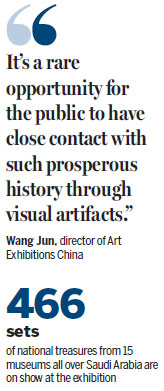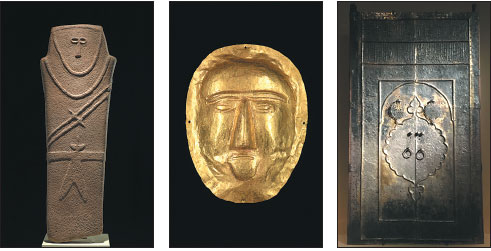Treasure exhibition unearths shared history and culture
Civilizations on two ends of Asia began a cultural dialogue not only across space, but also through time.
The Roads of Arabia: Archaeological Treasures of Saudi Arabia exhibition, which gathers 466 sets of national treasures from 15 museums all over Saudi Arabia, opened in the National Museum of China in Beijing on Tuesday and will run until March 19, 2017.
The exhibition tour has been to nine top-level museums in Europe and the United States before coming to Beijing, its first station in East Asia, and has attracted a combined four million visitors worldwide.
"This is the biggest number since we started Arabian exhibitions (around the world) six years ago," said professor Ali Ibrahim Al-Ghabban, general supervisor of the King Abdullah Cultural Heritage Care Project and curator of the ongoing exhibition.
According to Al-Ghabban, many exhibits in Beijing have shown new archaeological discoveries in Saudi Arabia in recent years, and more than 60 artifacts have never been exhibited out of his country.

"Few archaeological discoveries in recent years have transformed our understanding of a region as the objects on view in Roads of Arabia," the curator said. "Mysterious stone inscriptions, monumental human statues, and finely crafted bronze figures highlight Arabia's history before the rise of Islam in the seventh century."
Ancient trading and pilgrimage routes compose two major lines connecting the artifacts, organized by six sections in the exhibition, spanning Saudi history from the earliest human settlements through the Neolithic Age and the pre-Islamic era, up to the early 20th century.
Some important yet lesser-known archaeological sites in Saudi Arabia, including the oasis sites of Al-Ula and Tayma, and the ancient wealthy city of Qaryat al-Faw, are also on display at the exhibition through their cultural relics.
"The cultures are probably mysterious for Chinese people," Wang Jun, director of Art Exhibitions China, which co-organized the exhibition, explained. "So, it's a rare opportunity for the public to have close contact with such prosperous history through visual artifacts."
His organization is China's national institution in charge of exhibition exchanges overseas. More than 200 Chinese exhibitions have been taken abroad since its establishment in 1971, but Wang said they have put more emphasis on bringing overseas exhibitions to China.
"Chinese and Saudi Arabian cultures are complementary," said Prince Sultan bin Salman bin Abdulaziz, chairman of the board of the Saudi Commission for Tourism & National Heritage. "Many people know Saudi Arabia because of its oil, but we want to show a different aspect.
"Beyond economic influence, Saudi Arabia also has a long history and an open mind, which will easily stir up resonance in China," the prince said. "Consequently, it's crucial to have such an exchange of culture between the two countries.
"Preserving history is to protect our future, and the two countries still have many spaces for cooperation in the cultural field."
Earlier this month, China's Ministry of Culture revealed plans to cooperate with Saudi Arabia in co-bidding to include the Maritime Silk Road ancient trade route onto the UNESCO World Heritage list.
"Saudi Arabia was a key bond connecting China and the West along the ancient Maritime Silk Road, and we have sites in Saudi Arabia which have already been listed as UNESCO World Heritage, like the Port of Jeddah," Al-Ghabban said, citing 15th-century Chinese navigator Zheng He's visit to Jeddah.
"We are planning excavations with Chinese archaeologists in several ancient ports. We're ready to cooperate with China on the Maritime Silk Road project."
He recalled that Chinese objects from the Tang (618-907) and Song (960-1279) dynasties were found in Saudi Arabia even in the middle of the desert. Some of them are also on display in Beijing in the exhibition.
"That proves communication flourished in the past, as it does today," the professor said. "And we also want to introduce more exhibitions and seminars on Chinese history to Saudi Arabia to share Chinese experiences on cultural heritage protection."
Wang added: "The ancient Maritime Silk Road was flourishing because of common development along the route, not only in China, but also in the Arabian Peninsula. The event helps us to echo the Belt and Road Initiative to better understand other civilizations today."
wangkaihao@chinadaily.com.cn
|
An exhibition of Saudi Arabian national treasures is being held at the National Museum of China in Beijing starting Tuesday.Jiang Dong / China Daily |
|
From left: An anthropomorphic stele from the fourth millennium BC; a gold funerary mask from the first century AD; door of the Ka’ba from 1635-36, during the Ottoman Empire.Photos Provided To China Daily |
(China Daily 12/23/2016 page11)










